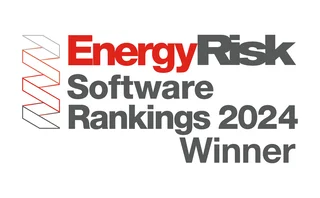
Market disruptions cause energy firms to seek advanced analytics, modelling and risk management capabilities


Geopolitical unrest and global economic uncertainty have caused multiple disruptions to energy markets in recent years, creating havoc for traders and other companies sourcing, supplying and moving commodities around the world
Amid ongoing uncertainty, it is imperative that firms have full visibility into their positions and risk exposures. They also require an enterprise-wide view of how events in the commodities markets might impact them. For firms that operate in multiple commodities markets, having this data in one connected system is a powerful tool. One firm that stood out on this front in the Energy Risk Software Rankings in 2024 was ION Commodities, winning widest product coverage for commodity derivatives software and physical commodities software.
In this year’s survey – which required the users of commodities software to vote for their preferred systems and vendors in an array of categories – ION Commodities took numerous first and second places.
As well as its wide product coverage, ION’s offering includes advanced data and analytics tools – a sought-after combination in today’s marketplace, says Sunil Biswas, chief product officer at ION Commodities. “We provide the advanced analytics and risk management capabilities companies use to model different market scenarios,” he says. “This means companies don’t need to wait for a disruption to figure out what to do. They can model it in advance and act as the market moves.”
We talked to Biswas about the macro trends influencing clients’ technology decisions and how artificial intelligence (AI) is set to create a different kind of disruption in commodities markets.
How has the current global economic picture affected your clients?

Sunil Biswas: Expectations following the Covid-19 pandemic were for supply chains to return to normal, albeit
with occasional temporary disruptions. But the Ukraine/Russia war and recent conflict in the Middle East have triggered multiple disruptions, many of which seem to have become permanent. Dubai has also emerged as a major trading hub for commodities and we’ve seen our clients move some business out of European centres, such as London and Geneva, to the Middle East.
In terms of commodity price trends, while volatility has come down somewhat, prices remain elevated – particularly in crude oil where Opec+ production cuts have kept prices high. Above-average prices raise profitability across the industry in general, and we tend to see more investment in commodity trading and risk management (CTRM) and technology at such times.
High interest rates have had an adverse effect, however. Clean-energy projects that need funding are now more expensive, for example, slowing investment in the energy transition.
Most of these macro trends mean clients need new or updated solutions to manage the trading, physical scheduling and operations of their business.
Taking the macro trend of the energy transition, for example, what types of solutions do clients want?
Sunil Biswas: We see two broad types of client. The first is a hydrocarbon or utility company diversifying into renewables. This typically involves onboarding renewable power or biofuels into an existing CTRM system. It’s not about switching on system functionality, but rather helping clients set up and run the new business and finding synergies – looking at the aggregated risk and optimising operations across renewable and traditional commodities.
The second is a renewable power or fuels company. The solutions they need are a little different and are typically focused on renewables, including certificate lifecycle management and connectivity to registries. ION Commodities provides these capabilities in its CTRM systems and offers Carbon Zero – a solution to manage carbon trading, credits and certificates for companies not necessarily already involved in physical commodities trading.
And since ION topped Energy Risk’s Software Rankings for its wide product coverage, what other areas have you been developing recently?
Sunil Biswas: We have a wide-ranging portfolio that spans commodity management needs. We have five CTRM systems and offer our clients a suite of complementary products beyond CTRM that provide supply-chain optimisation, advanced risk analytics and specialist commodity logistics management.
Within our finite element analysis solution, for example, we have introduced battery storage optimisation capabilities combined with renewable power generation. This is in addition to equivalent models already offered for natural gas, liquified natural gas (LNG), fuel and oil storage.
We also support shipping companies and commodities firms that use vessels. Our Softmar solution optimises voyage costs by finding the most effective shipping route. We’ve seen an uptick in interest in this as more US firms export LNG to western Europe.
Separately, we have also seen a lot of start-ups replace spreadsheets with CTRM systems. We’ve evolved our software-as-a-service solution to provide an ‘out-of-the-box’ CTRM to help bootstrap companies starting out with just a few employees.
What is the appetite now for cloud‑based systems?
Sunil Biswas: Most of our customers have a cloud strategy in place already and now want to take advantage of cloud-native features.
Commodity-intensive firms want to be able to scale their trading systems up and down on demand to deal with unexpected market events. Unfortunately, everybody’s going to scale up at the same time, so systems must provide access to more compute capacity and system resources when it matters. They also want to be able to dial it back when the system is not in use to keep costs down. These auto-scaling capabilities leverage cloud-native features.
Many firms have been using CTRM systems for more 10 years, and have substantial data history locked up in associated databases. Our clients want to use this CTRM data, alongside other data from across the organisation, for more holistic business planning and optimisation. Unlocking data is much easier when consolidated on cloud-based platforms.
Is AI the next frontier for CTRMs?
Sunil Biswas: There is a fundamental belief that AI is going to have a major impact on our daily lives, so it absolutely needs to be factored into CTRM solutions.
News of unexpected events now travels around the world instantaneously, causing exaggerated shocks to markets. So the need for real-time position and exposure management, and to take timely corrective action to hedge risk, is paramount. Companies can leverage AI to react quickly and make informed decisions.
The commodities industry has complex regulatory standards and the data is not structured in a way that is easy to analyse. So AI will also support automation and help firms on their digitalisation journey.
Sponsored content
Copyright Infopro Digital Limited. All rights reserved.
You may share this content using our article tools. Printing this content is for the sole use of the Authorised User (named subscriber), as outlined in our terms and conditions - https://www.infopro-insight.com/terms-conditions/insight-subscriptions/
If you would like to purchase additional rights please email info@risk.net
Copyright Infopro Digital Limited. All rights reserved.
You may share this content using our article tools. Copying this content is for the sole use of the Authorised User (named subscriber), as outlined in our terms and conditions - https://www.infopro-insight.com/terms-conditions/insight-subscriptions/
If you would like to purchase additional rights please email info@risk.net